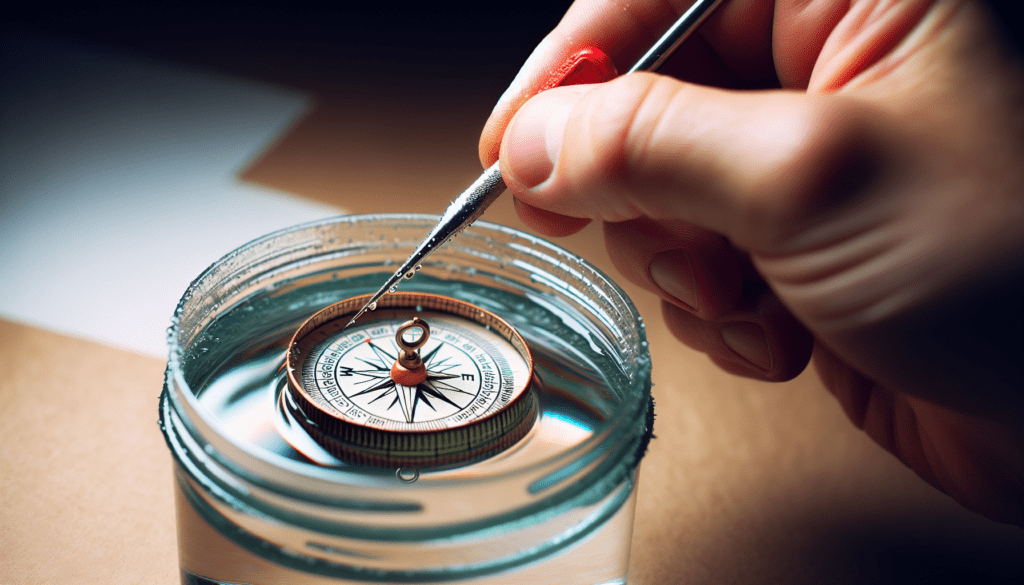Have you ever found yourself in a situation where you needed a compass but didn’t have one on hand? Fear not, because in this article, you will learn how to make a homemade compass using simple materials that you probably already have lying around your house. Whether you’re out exploring in the great outdoors or just intrigued by science experiments, this step-by-step guide will show you how to create a functional compass that can help you find your way. So grab your materials and get ready to embark on a compass-making adventure that’s both educational and fun!
Materials
To make a homemade compass, you will need a few simple materials that are easily accessible. These materials include a magnet, a needle, a cork, a small container, and some water. With these items in hand, you’re ready to start the compass-making process!
Preparing the Magnet
The first step in making a homemade compass is preparing the magnet. You’ll want to select a suitable magnet that is strong enough to magnetize the needle. It’s important to choose a magnet that is capable of attracting metal objects, as this will ensure the compass works effectively. Once you have your magnet, you can begin magnetizing the needle. Simply stroke the needle along the magnet in one direction multiple times. This process aligns the magnetic domains in the needle, making it magnetized and ready for use. Next, attach the magnetized needle to the magnet using adhesive tape or glue, ensuring that it is securely fastened.

Assembling the Compass
With the magnetized needle ready, you can now move on to assembling the compass. Start by preparing the cork, which will act as a base for the needle. Trim the cork to a suitable size, ensuring it’s large enough to securely hold the needle. Once you have the cork ready, insert the needle into the cork vertically, making sure it stands straight up. To balance the needle, gently spin it and observe if one side consistently points downwards. If it does, add a small amount of clay or wax to the heavier end to achieve balance. Finally, attach the cork to the small container using adhesive tape or glue, ensuring that it is centered and upright.
Calibrating the Compass
Now that the compass is assembled, it’s time to calibrate it. Start by aligning it with Earth’s magnetic field. Hold the compass horizontally, allowing the needle to rotate freely. Gradually turn yourself until the needle aligns with the Earth’s magnetic field, which is typically indicated by the needle pointing towards the north. Once the needle is aligned, carefully mark the north direction on the container using a marker or a small sticker. This mark will serve as a reference point when using the compass.

Testing the Homemade Compass
With the compass calibrated, it’s time to test its functionality. Start by finding the north direction using your compass. Hold the compass horizontally, ensuring it is level, and observe where the magnetized needle points. The north direction should correspond to the marked point on the container. To check the accuracy of your compass, compare its readings with a commercial compass or a known reference point. If the readings are consistently accurate, you can be confident in the performance of your homemade compass. For assurance, you can repeat the entire process of magnetizing the needle, assembling the compass, and calibrating it to further ensure its reliability.
Troubleshooting
If you encounter any issues with your homemade compass, don’t worry. There are a few common troubleshooting steps you can take to resolve them. If your needle is sticking to the container and not rotating freely, it’s possible that the container or the cork is magnetized. To fix this issue, try using a different container or cork that is not magnetic. If you’re experiencing inaccurate readings, double-check the calibration process to ensure the needle is properly aligned with the Earth’s magnetic field. For an unstable needle that refuses to stay balanced, consider using a smaller and lighter needle or adding more clay or wax to achieve better balance.

Alternative Methods
While the traditional homemade compass uses a magnetized needle, there are also alternative methods to explore. For example, you can use a magnetized paperclip as your needle, simply by attaching it to the cork or container. Another option is to utilize a bowl of water with a floating needle. Place a needle in the water, and the buoyancy will allow it to float and align with the Earth’s magnetic field. Lastly, you can get creative and make a DIY compass with a leaf. Suspend a lightweight leaf from a thread and allow it to rotate freely, observing its orientation as it aligns with Earth’s magnetic field.
Educational Applications
Making a homemade compass can serve as a great educational activity, especially for children. It provides a hands-on experience that teaches them about magnetism and its role in navigation. By building and using a compass, children can better understand how the Earth’s magnetic field works and how it can be used for orientation. This activity also introduces them to basic principles of navigation, such as finding true north and using reference points. Overall, the homemade compass activity fosters a sense of curiosity, discovery, and scientific exploration.

Safety Precautions
While making a homemade compass is a relatively safe activity, it’s important to take some safety precautions, especially when working with magnets. When handling magnets, be careful not to pinch your fingers or get them caught between two magnets, as this can cause injury. Additionally, it’s essential to supervise children during the compass-making process to ensure they handle the materials safely. Finally, avoid placing the compass near electronic devices, as the magnet can interfere with their operation.
Conclusion
In conclusion, making a homemade compass is a fun and educational project that anyone can undertake. By following the steps outlined here, you can create a functional compass using simple materials like a magnet, needle, cork, container, and water. The process involves preparing the magnet and attaching it to the needle, assembling the compass using a cork and container, calibrating it to align with Earth’s magnetic field, and testing its functionality. Troubleshooting tips are provided for common issues, and alternative methods are suggested for further exploration. This homemade compass can be a useful tool in emergencies or outdoor activities, providing a sense of direction and helping you navigate with confidence. So why not give it a try and embark on a compass-making adventure today?

